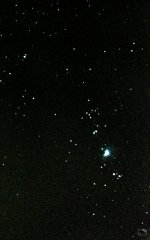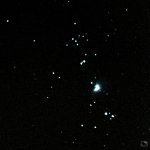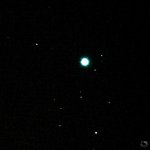Does anyone know how to calculate the exact shutter limit I can use with each lens/sensor?
I read about the rule of 600 at the one place, the rule of 500 at another yet none of them seems to be very correct in my case. I used the 18mm for 20s and even while that's just 360 and within range of both rules, when I check 1:1, I see the stars stretch. The full shot is ok but the moment I want to crop it's a no-go.
Strangely when shooting my 200mm at 2s shutter they're pretty ok even at 1:1.
In respect to the 500 or 600 rule to plan your shutter speed. My curiosity went further as I wasn't satisfied with the results using those rules. I need to know how far the movement of the stars is on the sensor in time. Luckily, like most things, a little arithmetic can get ya there.
This formula will give you more to help in determining your shutter speed. Notice that considering the crop of a sensor is not necessary.
D=T x FD/13750 x is the sign for multiplication
D is the distance of (or size of a pixel)
T is time, what we want to know (How long does it take for the light of the star to move one pixel on the sensor).
FD is focal distance
13750 is what I call hard arithmetic, someone else figured out the movement of the sky as we see it during the rotation of our planet.
To determine D: Take the sensor horizontal dimension and divide by the pixel count across the sensor. Example of the D5500 and D7200: 24.1mm / 6000 pixels = .00392
0.00392=T x 24(24mm lens)/13750
0.00392=T x 0.00174
0.00392/0.00174= T
T= 2.25 seconds the time the light on the sensor moves one pixel.
Using the rule of 500, 500/24=20.83.....20.83/1.5 (crop sensor)=13.88 seconds of exposure. 13.88/2.25=6.16 pixels of travel across the sensor. A 10mm lens will bring that camera up to 5.37 seconds per pixel.
Roughly, with the D5500 and 24mm lens, stars are between 5 and 30 pixels wide at a 13 second exposure. So, knowing that, you can decide how much trailing is acceptable to you.
As you can imagine, high pixel sensors may or may not be the best for night sky. Fat pixels good and slim pixels not as good. With a D4 and a 24mm lens, you get 4.82 seconds of exposure to one pixel of movement (a 12.1mp FX sensor). With that said, we are using the pixel as a measuring unit when each sensor may have a different pixel size.
The D810 and a 24mm lens, will get you 2.80 seconds of exposure to one pixel of movement (a 36.3mp FX sensor).
Note that lens size has an impact too: 10mm very good, 50mm not so good.
Disclaimer......This is just a few cents from a large bottle of pennies, don't take it too serious.



